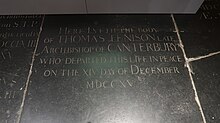Thomas Tenison
Simon Dubois | |
|---|---|
| Church | Church of England |
| Diocese | Canterbury |
| In office | 1695–1715 |
| Predecessor | John Tillotson |
| Successor | William Wake |
| Orders | |
| Consecration | 10 January 1692 by John Tillotson |
| Personal details | |
| Born | 29 September 1636 Cottenham, Cambridgeshire, England |
| Died | 14 December 1715 (aged 79) London, England |
| Nationality | English |
| Denomination | Anglican |
| Spouse | Anne Love |
| Education | Norwich School |
| Alma mater | Corpus Christi College, Cambridge |

Thomas Tenison (29 September 1636 – 14 December 1715) was an English church leader, Archbishop of Canterbury from 1694 until his death. During his primacy, he crowned two British monarchs.
Life
He was born at Cottenham, Cambridgeshire, the son and grandson of Anglican clergymen, who were both named John Tenison; his mother was Mercy Dowsing. He was educated at Norwich School, going on to Corpus Christi College, Cambridge, as a scholar on Archbishop Matthew Parker's foundation. He graduated in 1657, and was chosen fellow in 1659.[2] For a short time he studied medicine, but in 1659 was privately ordained. As curate of St Andrew the Great, Cambridge from 1662, he set an example by his devoted attention to the sufferers from the plague. In 1667 he was presented to the living of Holywell-cum-Needingworth, Huntingdonshire, by the Earl of Manchester, to whose son he had been tutor, and in 1670 to that of St Peter Mancroft, Norwich.[3]
In 1680 he received the degree of Doctor of Divinity, and was presented by King
Under King William III, Tenison was in 1689 named a member of the ecclesiastical commission appointed to prepare matters towards a reconciliation of the Dissenters, the revision of the liturgy being specially entrusted to him. A sermon he preached on the commission was published the same year.[3]
He strongly supported, at least in public, the Glorious Revolution, though not without some private misgivings, especially concerning the ejection of Archbishop William Sancroft and the other "non-juring" bishops. Henry Hyde, 2nd Earl of Clarendon in his diary records some frank remarks made by Tenison on this subject at a dinner party in 1691:
That there had been irregularities in our settlement; that it was wished that things had been otherwise, but that we were now to make the best of it, and support this government as it was, for fear of a worse.
He preached a funeral sermon for Nell Gwyn in 1687, in which he represented her as truly penitent – a charitable judgment that did not meet with universal approval. The general liberality of Tenison's religious views won him royal favour, and, after being made Bishop of Lincoln in 1691, he was promoted to Archbishop of Canterbury in December 1694.[3]

Archbishop of Canterbury
He attended Queen
Under Queen Anne
Along with
Increasingly he lost influence to
Other works
Besides the sermons and tracts above mentioned, and various others on the "Popish" controversy, Tenison was the author of The Creed of Mr Hobbes Examined (1670) and Baconia, or Certain Genuine Remains of Lord Bacon (1679). He was one of the founders of the Society for the Propagation of the Gospel.[10]
Family
He married Anne, daughter of
In appearance, he was described as a large, brawny, "hulking" figure, very strong when young but afflicted with gout in later life.[14]
Armorials
The personal
These arms are a
Suspected discovery of his coffin

In 2016, during the refurbishment of the Garden Museum,[15] which is housed at the medieval church of St Mary-at-Lambeth,[16] 30 lead coffins were found; one with an archbishop's red and gold mitre on top of it.[17] Two archbishops were identified from nameplates on their coffins; with church records revealing that a further three archbishops, including Tenison, were likely to be buried in the vault.[18]
See also
- Archbishop Tenison's School, Croydon
- Archbishop Tenison's School, Lambeth
- List of Archbishops of Canterbury
Notes
- ^ Burkes General Armory, 1884
- ^ "Tenison, Thomas (TNY653T)". A Cambridge Alumni Database. University of Cambridge.
- ^ a b c d e f Chisholm 1911, p. 617.
- ^ Gregg, Edward Queen Anne Yale University Press 1980 p.102
- ^ Gregg p.206
- ^ Somerset, Anne Queen Anne Harper Press 2012 p.224
- ^ Gregg p.146
- ^ Gregg p.141
- ^ Somerset p.540
- ^ Chisholm 1911, pp. 617–618.
- ^ . Dictionary of National Biography. London: Smith, Elder & Co. 1885–1900.
- ^ . Dictionary of National Biography. London: Smith, Elder & Co. 1885–1900.
- ^ George Stanhope, A Letter from the Prolocutor to the Reverend Dr. Edward Tenison, Archdeacon of Carmarthen, 1718
- ^ Somerset p.224
- ^ Museum web-site
- ^ Church of St Mary, Lambeth British History on-line
- ^ Times on-line
- ^ "Remains of five 'lost' Archbishops of Canterbury found". BBC. 16 April 2017.
References
- This article incorporates text from a publication now in the public domain: Chisholm, Hugh, ed. (1911). "Tenison, Thomas". Encyclopædia Britannica. Vol. 26 (11th ed.). Cambridge University Press. pp. 617–618.
- Hutton, William Holden (1898). . In Lee, Sidney (ed.). Dictionary of National Biography. Vol. 56. London: Smith, Elder & Co.
- Marshall, William. "Tenison, Thomas (1636–1715)". doi:10.1093/ref:odnb/27130. (Subscription or UK public library membershiprequired.)
Further reading
- Edward Carpenter, Thomas Tenison, Archbishop of Canterbury: His Life and Times (SPCK, 1948).
